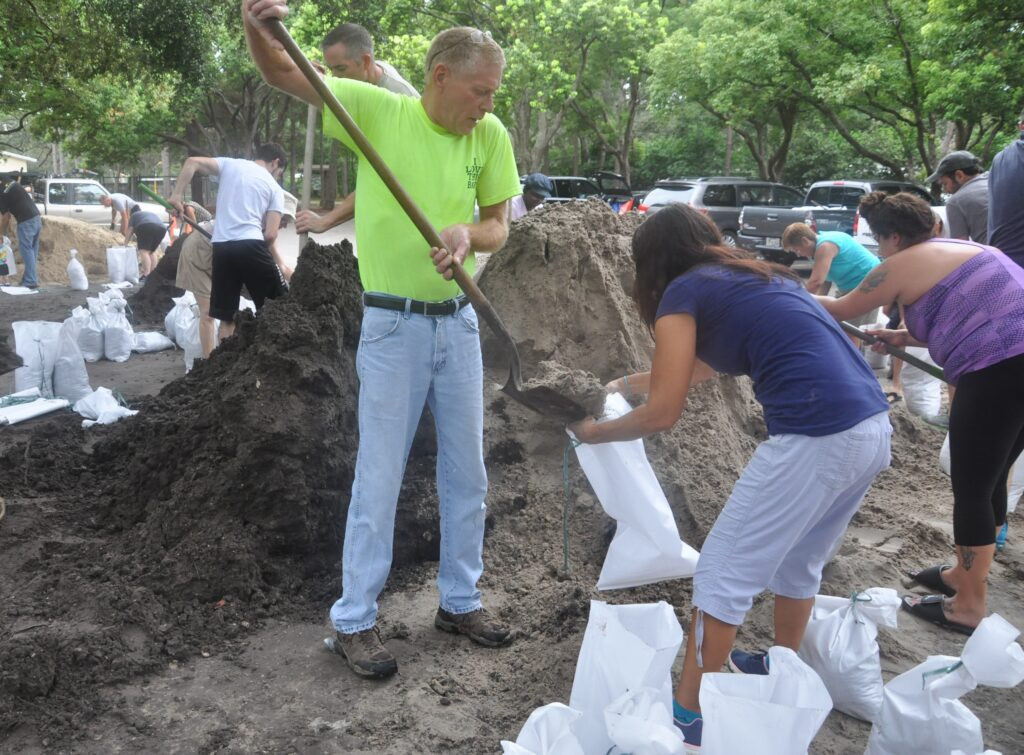When facing the threat of minor flooding, especially from rain or tides, sandbags can be a crucial first line of defense for your home. While they might not offer complete protection against water intrusion, particularly during larger storms with waves or storm surges, they can significantly reduce the amount of water entering your property. If you’re wondering “Where To Get Sandbags Near Me,” this guide will provide you with the essential information to prepare effectively.
Understanding Sandbags and Their Limitations
Sandbags are a traditional and readily available method for diverting water. They are most effective in situations where floodwaters are expected to be less than 15 inches deep. It’s important to understand that sandbags are not a foolproof solution. They are permeable and won’t create a watertight seal. For more severe flooding scenarios, or when dealing with powerful waves and storm surges, more robust flood barriers are necessary. Keep in mind that local authorities may have specific guidelines and resources available during flood events, but it’s always wise to be prepared in advance.
Finding Sandbags in Your Area
Locating sandbags quickly is crucial when a flood threat arises. Here are common places to find sandbags near you:
- Home Improvement Stores: Retailers like Lowe’s and Home Depot typically stock sandbags and the materials to fill them (sand and empty bags). These stores are generally a readily accessible option for purchasing sandbags before a storm. Search online for “home improvement stores near me” to find the closest locations.
- Local Hardware Stores: Smaller, local hardware stores are another excellent resource. They often provide more personalized service and may be closer to your home than large chain stores. Searching for “hardware stores near me” can help you find these local suppliers.
- Municipal and County Sandbag Distribution Sites: During declared emergencies or in anticipation of significant flooding, your local city or county might set up sandbag distribution sites. These are often free or low-cost for residents. Check your city or county’s official website or social media channels for announcements about sandbag distribution locations and availability. Be aware that there may be limits on the number of sandbags provided per household to ensure equitable distribution.
- Fire Departments: In some communities, local fire departments may offer sandbags to residents, especially in areas prone to flooding. Contact your local fire department (non-emergency line) to inquire about sandbag availability.
Remember to search online using terms like “sandbags near me,” “where to buy sandbags,” or “sandbag suppliers near me” to find the most up-to-date information and locations in your vicinity.
 People shoveling sand into sandbags
People shoveling sand into sandbags
Residents in Largo filling sandbags before Hurricane Irma, illustrating community preparedness for flood events.
Exploring Sandbag Alternatives for Enhanced Protection
While sandbags are a common choice, several alternatives can offer improved flood protection and reusability:
- Flood Bags and Barriers: These are commercially available products designed for flood control. They are often made from absorbent polymers that expand when they come into contact with water, creating a barrier. Flood bags are generally lighter and easier to store than traditional sandbags before activation.
- Flood Gates: Flood gates are designed to be installed at doorways and other building openings. They create a watertight seal and offer superior protection compared to sandbags, especially for extended periods of flooding.
- Water-Activated Dams: Similar to flood bags, water-activated dams utilize water-absorbent materials to create a barrier. They can be deployed quickly and are reusable, making them a practical alternative for repeated flood threats.
These alternatives are typically available at home improvement stores and online retailers. While they may have a higher upfront cost than sandbags, their reusability and potentially greater effectiveness can make them a worthwhile investment for long-term flood preparedness.
Best Practices for Using Sandbags
To maximize the effectiveness of sandbags, follow these guidelines:
- Filling Sandbags: Fill sandbags to about two-thirds capacity and tie them securely. Overfilled sandbags are harder to handle and don’t stack as effectively.
- Placement: Place sandbags in a staggered pattern, like bricks, to create a more stable and water-resistant barrier. Tuck the open end of each bag under to prevent sand from escaping.
- Foundation: Place sandbags on a level surface and consider using a plastic sheet as a base to further reduce water seepage.
- Doorways: For doorways, create a pyramid shape with sandbags, with the base wider than the top, to divert water away from the entrance.
Consult resources from reputable sources like Lowe’s or your local emergency management agency for detailed instructions and visual guides on sandbag deployment techniques.
Sandbag Reuse and Responsible Disposal
Properly handling sandbags after a flood event is essential, both for potential reuse and safe disposal.
Handling Clean Sandbags
If your sandbags did not come into contact with floodwaters, you can reuse them.
- Storage: Store clean sandbags in a cool, dry place, away from direct sunlight to prevent degradation of the bags.
- Sand Disposal (Clean): The sand from clean sandbags can be spread in your yard or garden.
- Bag Disposal (Clean): Empty bags can be disposed of in your regular trash. Do not put them in recycling bins.
Handling Sandbags Contaminated by Floodwater
Sandbags exposed to floodwater may be contaminated with harmful substances.
- Safety Precautions: Wear gloves and a dust mask when handling potentially contaminated sandbags.
- Contaminated Sand Disposal: Do not reuse sand that has been in contact with floodwater. Do not spread contaminated sand in gardens or areas where people or pets may come into contact with it.
- Contaminated Sandbag Disposal: Contact your local solid waste disposal complex for guidance on disposal. They may have designated locations for flood debris. In some cases, disposal fees for flood-contaminated sandbags may be waived during specific periods following a flood event. Do not place contaminated sandbags in your regular trash or yard waste.
By understanding where to get sandbags near you, how to use them effectively, and how to handle them after a flood, you can significantly enhance your preparedness for minor flooding events and protect your property. Remember to stay informed about local flood risks and heed any warnings or instructions from local authorities.

